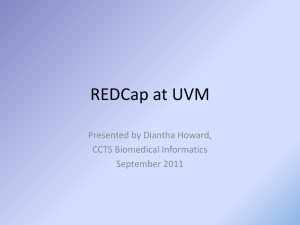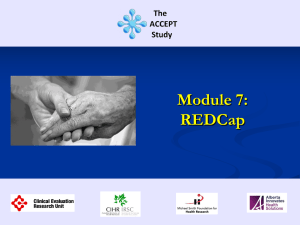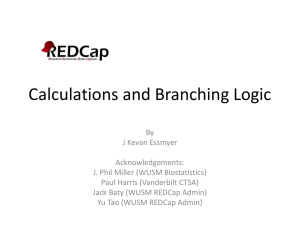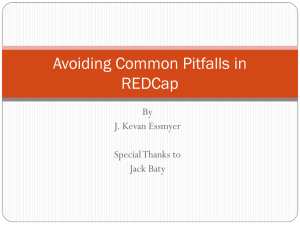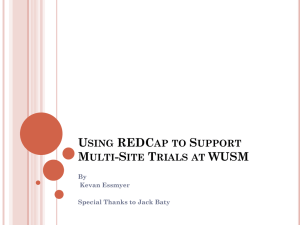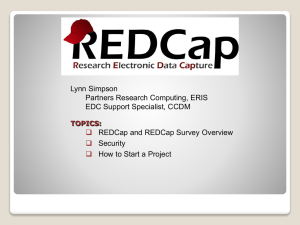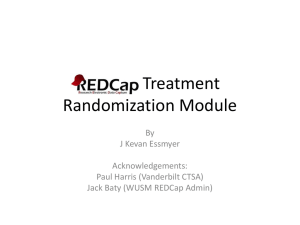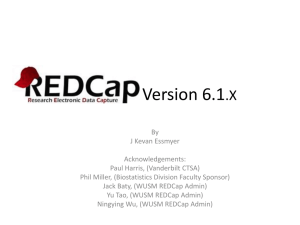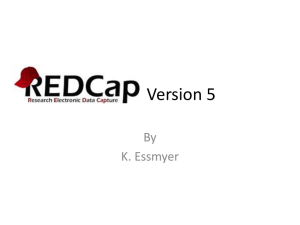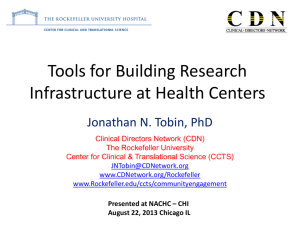Research electronic data capture (REDCap)
advertisement
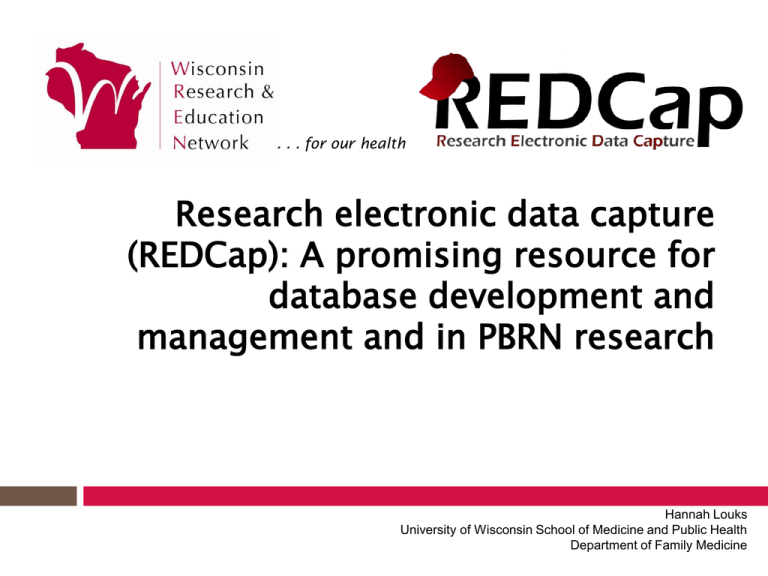
. . . for our health Research electronic data capture (REDCap): A promising resource for database development and management and in PBRN research Hannah Louks University of Wisconsin School of Medicine and Public Health Department of Family Medicine Outline • • • • • • • • What is REDCap? Background Why WREN uses REDCap Overview of key features Surveys Tips for good design Limitations Resources What is ? • Research Electronic Data Capture • Used for building and managing surveys and databases quickly and securely ▪ This includes protected health information (PHI) • 462 consortium partners and rapidly growing • Developed at Vanderbilt University in 2004 Background: Challenges across PBRNs ▪ 116 primary care PBRNs ۰ 73% of practices have collaborated with another PBRN or plan to ▪ National studies across PBRNs (i.e. CKD Guideline project) ▪ Continued need to share data quickly and securely across PBRNs ۰ Especially so with new AHRQ Research Centers (P30s) Background: Challenges within PBRNs ▪ Vast distribution of PBRN members across states/regions ▪ Multicenter research designs ▪ Multisite research networks (i.e. WREN) ▪ Need to share data quickly and securely across sites Background: Data Management and Quality • Substantial coordination and management needed to ensure high data quality, addressing: ▪ Accessibility ▪ Accuracy ▪ Completeness ▪ Comprehensiveness ▪ Security • Why is this important? ▪ Ensures consistency ▪ Instills confidence in stakeholders, participants, etc. ▪ Lays groundwork for uncomplicated data cleaning and analysis Some reasons uses • Regional Research Coordinators can create data collection forms and surveys without the need for a programmer. (Although, will need a programmer to facilitate REDCap startup and software maintenance.) • RRCs can access data for multicenter studies regardless of where data collection is taking place (i.e. in a practice, remote chart abstraction from the office, etc.) • All data stored on REDCap compliant with UW IRB HIPAA standards for security. • Audit trails for tracking data manipulation and import/export. • Suitable for (almost) any multi-site study with webbased data entry capabilities. Surveys vs. Data entry forms -“Read-only” after submission -Can modify data at any time, as long as permitted -Data entry performed by the participant -Report building -URL can give access to form, regardless if REDCap user -Scheduling module -Can be built using online designer or offline data dictionary -Audited data entry -Data entry performed by research team -Authorized REDCap users only Sample case report form Web-based data collection form builder Data dictionary: Offline method for building data collection form Audit Trail Field Types • Field Types (13 types) ▪ ▪ ▪ ▪ Text box Notes box Calculated field Multiple choice ۰ Radio and dropdown buttons ۰ Must select one answer only ▪ ▪ ▪ ▪ ▪ ▪ ▪ Checkboxes (Multiple answers) Yes/No Begin new section True/False Slider/Visual Analog Scale File upload Descriptive Text • Matrix of Fields Field Types: Screen Shots Text Box Notes Box File Upload Field Types: Screen Shots Calculated Field Radio Buttons Checkboxes Dropdown Field Types: Screen Shots Yes/No Section Header True/False Slider/Analog Scale Text Box Validation Option • Hard Validation - Error message displayed if entry does not match expected format and entry not saved. • Soft Validation - Minimum & Maximum Values ▪ ▪ Can enter (not required) for date, integer, number, and time options. Will alert data enterer if entry is outside of range, but will still save entry. Required and Identifier Fields • Required – Will alert data enterer if “required” field is left blank, but will allow you to opt to leave blank. • Identifier – Tags variables with PHI for removal option during export. Matrix of Fields • Ideal for grouping of questions that share same response options (i.e. Likert scale questions) • “Answer Format” can be specified as radio buttons or checkboxes. Screen shot courtesy of University of Iowa ICTS. Branching Logic • Can be applied to a field to specify whether it will be displayed depending on information from other fields. • ‘Section Header’ is the only field type that does not allow branching logic. Quality Control Data Access Groups Allow multiple groups to enter data in one database without groups being able to view each other’s data. Reports, Graphs, and Descriptive Stats REDCap can display data using three different graphs types: bar charts, pie charts, and scatter plots. Can navigate to a specific data record within REDCap by clicking on the associated data marker Data Visualization Easily identify potential outliers. Data Export REDCap Survey Pros •Private or public links Cons •May only create one survey per project •Responses are secure •Ability to e-mail non-respondents •Multiple options and features for customizability •Survey responses can not be changed once submitted (by either the respondent or the data enterer) Survey Options • Triggers & Notifications ▪ You or other users will be notified via e-mail every time a respondent completes a survey • “Save & Return Later” option ▪ Allows respondents to save a partially completed survey and complete the remaining portion at a later time. ▪ Respondents will be given a unique validation code to enter when they return to the survey. ۰ If the validation code is lost, the researcher can NOT recover this for the respondent – Keep this in mind when selecting this option. • Allow participants to view aggregate survey responses Example: Screening Survey (and miscellaneous features) Use HTML tags for font control Reverse scoring Example: Screening Survey cont. Screen shown to respondent Tips for Good Design • “Don’t use a hammer to swat a fly off someone’s head.” ▪ Just because technology is available, does not mean you should use it. • Group similar information into sections. • Go through multiple trial runs with your database before moving a project to “production mode.” ▪ Allows for less confusion down the road. Limitations • Limited flexibility in form design • Data entry on online form only possible with web or 3G connection • Once a project is in “production mode,” any changes must be submitted to a REDCap administrator for approval ▪ Some revisions may not be allowed (i.e. changing variable names) • Not 21 CFR Part 11-compliant (not suitable for FDA governed clinical trials) Resources • http://project-redcap.org ▪ REDCap Shared Library – a repository for REDCap data collection instruments and forms that can be downloaded and used (for free) by consortium partners ▪ Video Resources – Webinars and tutorials References & Acknowledgements • • • • • Paul Smith, Melody Bockenfeld, Mark Remiker, Kate Judge, and Don Thomson Harris PA, Taylor R, Thielke R, Payne J, Gonzalez N, Conde JG. Research electronic data capture (REDCap) – A metadata-driven methodology and workflow process for providing translational research informatics support. J Biomed Inform. April 2009;42(2): 377-381. Pace WD, Staton EW. Electronic data collection options for practicebased research networks. Ann Fam Med. 2005;3(Suppl 1): S21-S29. Practice Based Research Networks (PBRN): PBRN Information. 14 May 2012. Available at http://pbrn.ahrq.gov/portal/server.pt/community/practice_based_resear ch_networks_%28pbrn%29__pbrn_information/855/pbrn_slides/28200 , Accessed 10 August 2012. Select REDCap screenshots used with permission from University of Chicago Initiative in Biomedical Informatics.
